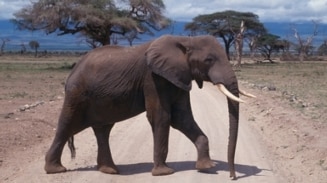
大象脚印成为小动物的避风港
Elephant Footprints Become Tiny Critter Havens
大象脚印成为小动物的避风港
When rain fills the massive footprints left by elephants, communities of aquatic invertebrates quickly move in.
当雨水充满了大象留下的巨大的足印,成群结队的水生无脊椎动物们迁移进来。
撰文/播音:杰森·戈尔德曼(Jason G. Goldman)
翻译:郭鑫鹏
审校:丁可含
Imagine a world without elephants. Not only would we have lost one of the planet’s most charismatic, extraordinary creatures. Also gone would be a network of ecosystem engineers-because elephants are crucial for other creatures to exist.
试着想象没有大象的世界,不仅我们会失去这个星球上这样一种魅力非凡的生物,还会失去许多生态系统网络的“工程师们“,因为大象对于一些其他生物的生存也相当重要。
They disperse seeds in their copious droppings. By literally cutting paths through forests as they trample trees and bushes, they create a more complex landscape. And now we know that their very footprints are important.
它们分撒种子在大量的粪便中。通过踩踏树木和灌木制造出森林中的道路,它们创造了一个更复杂的地貌。现在我们知道它们巨大的脚印十分重要。
“We were walking through the forest in Kibale National Park…and that’s when we stumbled upon these water-filled elephant footprints.”
“我们穿过基巴莱国家公园内的森林时,偶然发现这些汪着水的大象脚印”
University of Koblenz-Landau ecologist Wolfram Remmers,
科布伦茨-兰道大学生态学家沃尔弗拉姆·雷默斯说。
“And we looked at them and we quickly noticed that they were not only filled by water, but there were lots of animals living in them,”
“我们观察这些足印然后很快发现其中并不仅仅充满了水,还有许许多多的动物在其中生活。”
Remmers and his colleagues discovered that elephant footprints are a critical habitat for aquatic invertebrates like water beetles. The team studied 30 footprints in different parts of the national park in Uganda to see just who calls this unique habitat their home. In all, they found 61 species from 27 taxonomic orders.
雷默斯和他的同事们发现大象脚印是许多如水甲虫等水生无脊椎动物非常重要的栖息地。他的团队研究位于乌干达的国家公园中30处不同的脚印,看看有哪些生物以这样独特的栖息地作为它们的家。最后,他们找到了27个目,61个物种。
The researchers then created 18 artificial footprints to see how fast they would be colonized. Water beetles showed up on day one. After five days, 410 individual invertebrates were occupying the prints. The findings are in the African Journal of Ecology. [Wolfram Remmers et al., Elephant(Loxodonta africana)footprints as habitat for aquatic macroinvertebrate communities in Kibale National Park, south-west Uganda.]
研究者们接着制造了18个人造脚印以观察它们是如何被开拓利用的。水甲虫在第一天出现了。五天后,410个无脊椎动物个体占据了这些脚印。该结果发表在《非洲生态学杂志》上[Wolfram Remmers et al., Elephant(Loxodonta africana)footprints as habitat for aquatic macroinvertebrate communities in Kibale National Park, south-west Uganda.]。
“If you think of these footprints as tiny islands in a big forest, it was amazing to me to see how quickly these small animals could find them and colonize them and use them as habitat for foraging and reproduction and living.”
“如果你把这些脚印看作巨大森林里的一个个小岛,我很惊讶,这些小动物们能够迅速找到、开拓并以它们作为觅食、繁殖、生存的栖息地。”
In some places, elephant footprints are the only stagnant ponds to be found, which could mean that these insects depend on the pachyderms for their very survival. But because this discovery is so new, nobody really knows how critical these habitats are.
某些地方,大象脚印是唯一能够找到的死水洼,因此这些昆虫要依靠大象这样的厚皮类动物生存。但是由于这是一项新发现,谁也不知道这些大象脚印的重要性有多大。
“We are not sure how much they are really dependent on elephant-made footprints in other areas, or if they would completely disappear or if they would just be there in a lower number,”
“我们并不确定在其他一些地方它们有多么依赖大象脚印,如果没有这些脚印,它们会消失或数量减少。”
Without additional protections, elephants will undoubtedly disappear from large swaths of their ranges. Which means a huge community of invertebrates might be severely restricted in their ability to move across the landscape—with ecosystem consequences we can only guess at.
如果不施加额外的保护,毫无疑问大象会大范围地消失,这意味着大量的无脊椎动物会受限于自身能力而难以穿越这些地形,我们可以猜测由此导致的生态系统的后果。
未经书面许可任何人不得复制或镜像
京ICP备11000850号-1
 京公网安备11010502039775号
京公网安备11010502039775号 信息网络传播视听节目许可证0111611号
国家科技基础条件平台

















